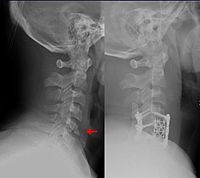
Photo from wikipedia
Purpose The purpose of this study was to assess the accuracy, safety, and survival of distal femoral osteotomy (DFO) surgery for lateral compartment OA of the knee. Methods A retrospective… Click to show full abstract
Purpose The purpose of this study was to assess the accuracy, safety, and survival of distal femoral osteotomy (DFO) surgery for lateral compartment OA of the knee. Methods A retrospective cohort study was conducted at a single UK centre, using prospectively collected data over an 8-year period (2009–2017). All patients had pre-operative radiographic analysis and digital planning of their deformity correction in addition to post-operative analysis of the achieved correction and yearly face-to-face follow-up. Complications (defined as an undesirable medical or surgical event as a direct result of the operation), reoperations, and failure (defined as conversion to arthroplasty or revision) were recorded. Results From a total of 83 patients, 81 patients undergoing 86 primary DFOs were included in this study, with a mean follow-up of 99 months (SD 27 months). The mean pre-operative percentage Mikulicz point was 78.7% (SD 19.1%) and post-operative 35.9% (SD 14.8%). The mean accuracy of correction (intended correction − achieved correction) was an 8.2% overcorrection (SD 13.7%). The complication rate was 4.7%. Using Kaplan–Meier analysis, the mean survival was 113 months (95% CI 106–120) with the probability of surviving 10 years 89%. Conclusion DFO for valgus alignment and lateral compartment arthritis is associated with low complications, long-term joint preservation, and the prevention of arthroplasty surgery. However, the accuracy of correction still requires improvement in intra-operative technique. Level of evidence IV.
Journal Title: Knee Surgery, Sports Traumatology, Arthroscopy
Year Published: 2020
Link to full text (if available)
Share on Social Media: Sign Up to like & get
recommendations!